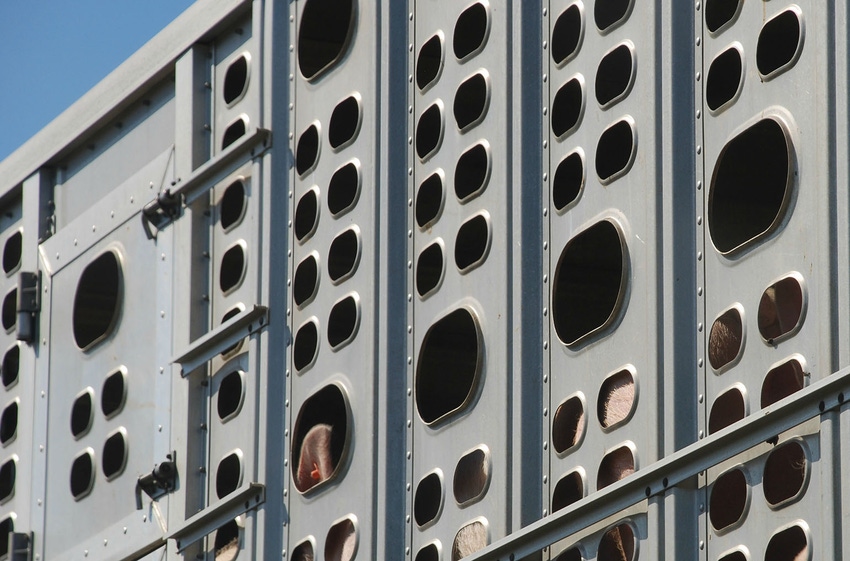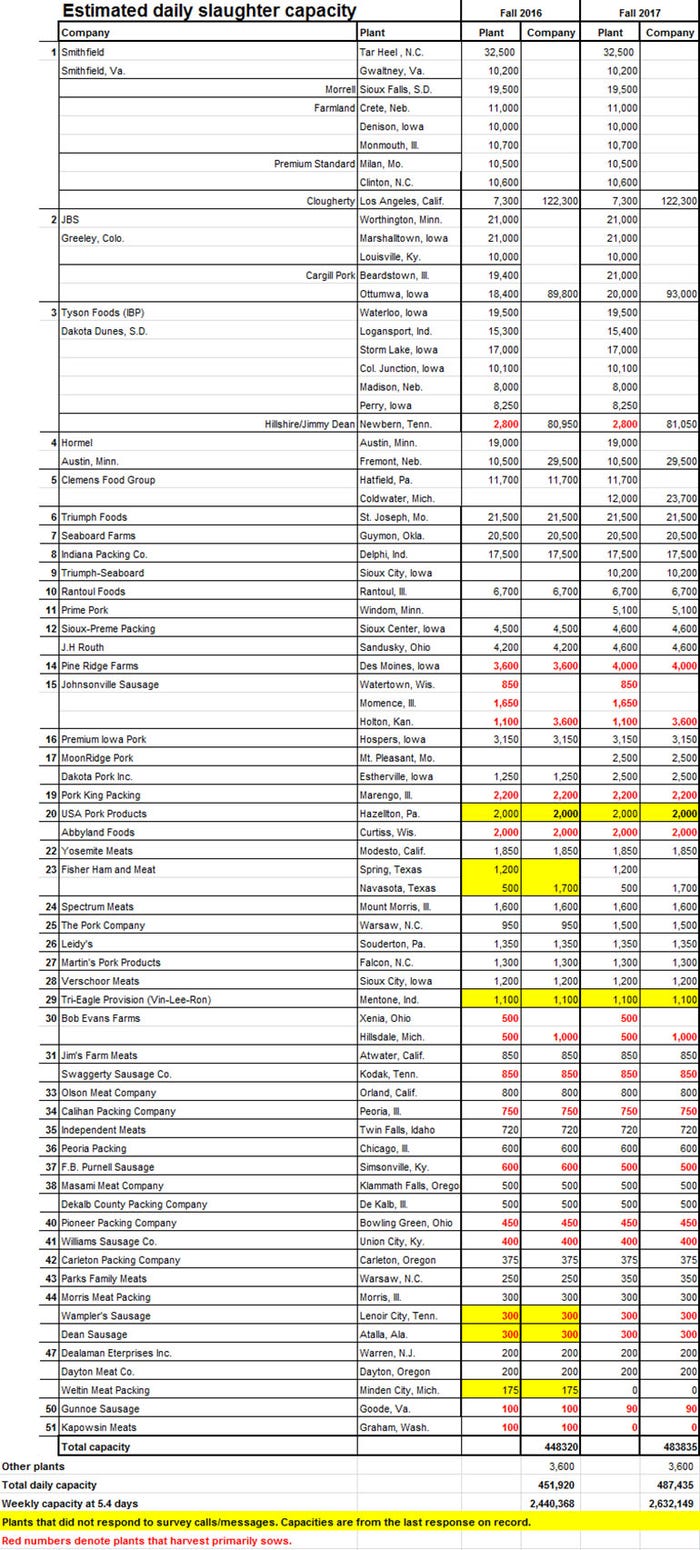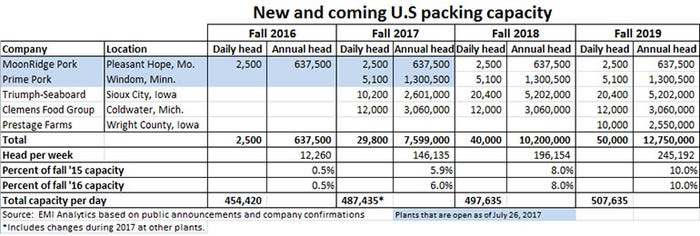The long-anticipated and long-awaited increase in U.S. hog slaughter capacity is finally at hand.
July 27, 2017

The long-anticipated and long-awaited increase in U.S. hog slaughter capacity is finally at hand. It began slowly last September when MoonRidge Pork opened its plant in Pleasant Hope, Mo., and continued this spring with the opening of Prime Pork in Windom, Minn. But the big jumps are coming this fall though there are still some questions about timing. Let’s hope the timing is good because even with the largest single increase in slaughter capacity in memory, larger hog numbers will once again test capacity this fall.
What’s new in this year’s rankings?
Note first that I have changed my time frame. Historically we have placed our capacity figures in the spring of the year in question. That fit the early to mid-summer timing of our survey and provided a “historical” perspective. This year, I have changed the time frame to the fall of the year since a) the two big plants are not yet open, but will be operational in the fourth quarter and b) the fall of the year is the critical time period during which our capacity is usually tested.

The big increases happen in the middle of the table. Clemens Food Group leads the way with their new plant in Coldwater, Mich., which will have a first-shift capacity of 12,000 head per day. Clemens has announced — and adamantly stood by the announcement — that they will commence operations on Sept. 5 with a ramp-up to full one shift capacity early next year. Several large eastern Corn Belt producers were instrumental in getting this plan built, but they do not own share in the plant. They actually invested in Clemens Food Group and now hold a minority stake in the entire company.
Triumph-Seaboard’s plant in Sioux City, Iowa, will have a first-shift capacity of 10,100 head per day. It, too, is officially scheduled to open Sept. 5, though significant industry chatter suggests that it will be at least late-September before the first pigs are harvested. This plant is a joint venture between Triumph Foods and Seaboard Foods. Note that we list the two parent companies and this plant as separate entities in spite of the clear interlocking ownership of this new plant. Officials at Triumph and Seaboard have been quite pointed in their statements that this will be a separate operating entity. The only known overlap of the two parent companies would be Seaboard’s marketing the pork products coming out of Triumph’s original St. Joseph, Mo., plant. Procurement at Triumph and Seaboard has always been independent and we understand that both marketing and procurement for the Sioux City facility will be independent of the other entities.

MoonRidge Pork (Mount Pleasant, Mo.) and Prime Pork (Windom, Minn.) are in this year’s table with capacities of 2,500 and 5,100 head per day, respectively. MoonRidge began operations last September and are still running less than 1,000 head per day. Cooler challenges have limited their ramp-up but company officials hope to have those solved soon. Prime Pork is reported to be operating in the 3,500 to 4,000 head per day range with an increase to 5,000 planned this fall.
JBS, as expected, increased the throughput at the plants that it acquired from Cargill last year. The 1,600 head per day increases at both the Beardstown, Ill., and Ottumwa, Iowa, plants added 8.5% to the capacity of the old Cargill plants. Capacity at JBS’s other three plants has not changed.
The only other increase of over 1,000 head per day was at Dakota Pork in Estherville, Iowa. This light hog processor doubled their capacity from one year ago, going from 1,250 to 2,500 head per day.
Several other companies expanded their capacities slightly during the past year. The largest of these was a gain of 550 head per day at The Pork Co. in Warsaw, N.C. The company has historically processed light hogs and a few heavy gilts when the opportunity arises, but has expanded into organic and antibiotic-free products.
The 100 head per day reduction for F.B. Purnell Sausage is an adjustment of their previous number. There was no change in Purnell’s operation.

Finally, we direct your attention to the bottom of our rankings for changes that, though they have little impact on total capacity, are noteworthy due to their drivers.
Weltin Meat Packing in Minden City, Mich., is still open for business and offering pork and beef products. However, they are no longer slaughtering pigs because, according to management, “We can’t find labor. No one wants to do the hard work required in a slaughter plant.” We have no idea what the local labor conditions are (though they are likely tight just as they are in much of rural America) or the wage that Weltin is offering, but this will not likely be the last we hear of this labor story. We have already heard rumors that labor is a reason for the delay in Sioux City and that is the largest town in which a new facility has or will begin operations. One would think the worker pool might be best there.
Kapowsin Meats suspended operations in late-August last year after a second round of salmonella contamination resulted in a number of sickened consumers. The company’s first round of difficulties was in December 2015 after which it re-opened, but then closed after another incident in July 2016 and the recall of over 116,000 pounds of whole roaster pigs.
The industry has had very few food safety issues that have actually caused human illness but this case is a warning on several fronts. What if it had been larger? In cuts or packaged meats instead of roaster pigs? If someone had actually died? Further, the consequences are clearly huge for a plant that has only one slaughter facility.
Will this be enough shackle space this fall? Assuming the two big plants can ramp up to half-speed by December, the industry should be able to process about 2.611 million head in a 5.4 day workweek. My forecasts based on the June Hogs and Pigs report would have slaughter peaking at 2.628 million head the week after Thanksgiving and getting to 2.626 million head two weeks later. Those are “handle-able” runs given the new capacity. Since we neither exceed capacity significantly nor do it for more than a couple of weeks, I foresee few, if any, price impacts from high capacity utilization. Prices will be lower because of large pork supplies but little of that downward pressure will come from plants being full and over-worked.
Full ramp-ups of the new plants and the addition of a second shift at Sioux City in 2018 will likely put us in a similar position next fall. The Prestage Farms plant in Iowa will, if it stays on schedule, be open in October 2018 but it will not provide much help until the spring of 2019.
Meyer is vice president of pork analysis for Express Markets Inc. Analytics of Fort Wayne, Ind. Meyer also frequently writes Market Preview columns for National Hog Farmer’s NHF Daily newsletter.
About the Author(s)
You May Also Like





